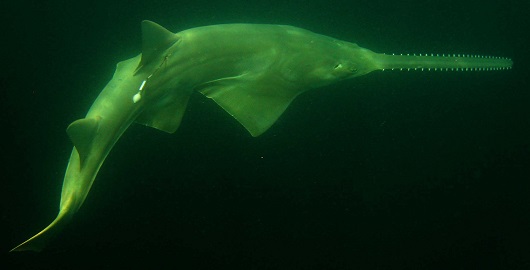Key to survival for world’s most bizarre fish

What may be the last habitat of one of the world’s most bizarre fish has been highlighted by a researcher at the University of St Andrews.
The smalltooth sawfish, which looks like a shark with a chainsaw on its nose and can grow up to 25ft in length, was once common in the oceans around the Americas but now faces extinction.
New research by Dr Yannis Papastamatious of University’s Scottish Oceans Institute in collaboration with the University of Florida, Florida State University and the U.S. National Marine Fisheries Service, has identified a subtropical bay off the coast of Florida which may hold the key to the survival of the rare animals.
Dr Papastamatiou, whose work is published in Global Ecology and Conservation, spent months tagging and tracking the rare creatures in the United States to unlock the secret of their movements providing vital information for conservationists.
“The sawfish are a very unique group of animals and are one of the most endangered groups of fishes,” he said.
“We want to promote awareness for these fishes which most people have never heard of. They truly are incredible animals. Even within Florida, most people have no idea they are there because the sawfish live in very murky water.
“It is vital to their survival as a species that we understand the importance of these bays and other coastal habitats.
“We always knew there were sightings of sawfish in Florida Bay, but we had no idea until now if these were just animals passing through, or if individuals resided in the bay. Now we know animals do stay there for months and some of them return over years and this may be a location critical to their survival.”
ENDS
NOTES TO NEWS EDITORS
“A subtropical embayment serves as essential habitat for sub-adults and adults of the critically endangered smalltooth sawfish” is published by Global Ecology and Conservation
http://www.sciencedirect.com/science/article/pii/S2351989415000293
All animals were collected under guidelines outlined in ESA permits 13330 and 17316
Photos of the sawfish are available. Dr Papastamatious is available for interviews. Contact Communication Office.
Issued by the University of St Andrews Communications Office, contactable on 01334 467310 or [email protected].
Category Research